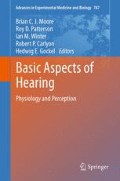Abstract
Room reverberation usually degrades speech reception, such as when listeners identify test words from a ‘sir’-to-‘stir’ continuum. Here, substantial reverberation introduces a ‘tail’ from the [s], which tends to fill the gap that cues the [t], and a degradation effect arises as listeners report correspondingly fewer ‘stir’ sounds. This effect is particularly clear when test words are preceded by a precursor phrase (e.g. ‘next you’ll get…’) that contains much less reverberation than the test word. When the precursor’s reverberation is increased to be the same as in the test word, the degradation diminishes as more ‘stir’ sounds are heard once again. This last effect has been attributed to a perceptual compensation mechanism that is informed by the precursor’s reverberation level. However, a recent claim is that the degradation is caused by ‘modulation masking’ from precursors with a low level of reverberation. Such masking is likely to diminish when the precursor’s reverberation level is raised, because reverberation acts as a low-pass modulation filter. Support for this hypothesis comes from results in conditions where degradation effects seem to be entirely absent, despite substantial reverberation. In these conditions, test words were played in isolation, with no precursor, and reverberation was kept at the same level in the test words of every trial. The experiments reported here have conditions that are similar, except that reverberation in test words is varied unpredictably from trial to trial, so that substantial-level trials are interspersed with trials that have a much lower level of reverberation. The result is that under these conditions, the degradation effect is entirely restored, allowing rejection of the modulation-masking hypothesis. An alternative is that some perceptual compensation comes from reverberation information within test words, and its effects accumulate over sequences of trials as long as the test word’s reverberation level stays the same from trial to trial.
Access this chapter
Tax calculation will be finalised at checkout
Purchases are for personal use only
References
Houtgast T, Steeneken HJM (1973) The modulation transfer function in acoustics as a predictor of speech intelligibility. Acustica 28:66–73
ISO 3382 (1997) Acoustics - measurement of the reverberation time of rooms with reference to other acoustical parameters. International Organization for Standardization, Geneva
Longworth-Reed L, Brandewie E, Zahorik P (2009) Time-forward speech intelligibility in time-reversed rooms. J Acoust Soc Am 125:EL13–EL19
Nábĕlek AK, Letowski TR, Tucker FM (1989) Reverberant overlap- and self-masking in consonant identification. J Acoust Soc Am 86:1259–1265
Nielson JB, Dau T (2010) Revisiting perceptual compensation for effects of reverberation in speech identification. J Acoust Soc Am 128:3088–3094
Watkins AJ (2005) Perceptual compensation for effects of reverberation in speech identification. J Acoust Soc Am 118:249–262
Watkins AJ, Makin SJ (1994) Perceptual compensation for speaker differences and for spectral-envelope distortion. J Acoust Soc Am 96:1263–1282
Watkins AJ, Makin SJ (2007) Perceptual compensation for reverberation in speech identification: effects of single-band, multiple-band and wideband contexts. Acta Acust United Acust 93:403–410
Watkins AJ, Raimond AP, Makin SJ (2011) Temporal-envelope constancy of speech in rooms and the perceptual weighting of frequency bands. J Acoust Soc Am 130:2777–2788
Wojtczak M, Viemeister NF (2005) Forward masking of amplitude modulation: basic characteristics. J Acoust Soc Am 118:3198–3210
Acknowledgements
This work was supported by a grant to the first author from EPSRC. We are grateful to Amy Beeston, Guy Brown, Peter Derleth, Kalle Palomäki and Hynek Hermansky for discussions.
Author information
Authors and Affiliations
Corresponding author
Editor information
Editors and Affiliations
Rights and permissions
Copyright information
© 2013 Springer Science+Business Media New York
About this paper
Cite this paper
Watkins, A.J., Raimond, A.P. (2013). Perceptual Compensation When Isolated Test Words Are Heard in Room Reverberation. In: Moore, B., Patterson, R., Winter, I., Carlyon, R., Gockel, H. (eds) Basic Aspects of Hearing. Advances in Experimental Medicine and Biology, vol 787. Springer, New York, NY. https://doi.org/10.1007/978-1-4614-1590-9_22
Download citation
DOI: https://doi.org/10.1007/978-1-4614-1590-9_22
Published:
Publisher Name: Springer, New York, NY
Print ISBN: 978-1-4614-1589-3
Online ISBN: 978-1-4614-1590-9
eBook Packages: Biomedical and Life SciencesBiomedical and Life Sciences (R0)

